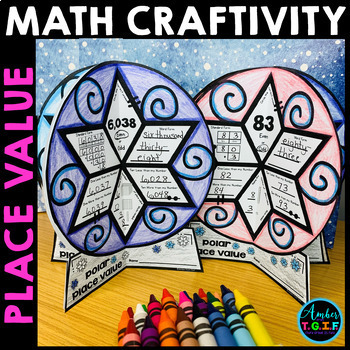Winter Math Craft Activities Place Value to 1000 Snow Globe Craftivity
- PDF
What educators are saying
Also included in
- Challenge your Second Grade class this winter with fun and engaging math crafts that will help reinforce and review the math concepts of 2-digit addition and subtraction with and without regrouping, place value, and addition with missing addends.Math craftivities are the perfect combination of art aPrice $12.00Original Price $15.00Save $3.00
- Math craftivities are the perfect combination of art and math for those of us short on time! They make the perfect display in your 2nd Grade hallway, classroom or even bulletin board to show off what you have been learning about and it is so easy to differentiate with so many options. These Second GPrice $34.83Original Price $49.75Save $14.92
Description
Combine art and math? Yes! This place value snowflake math craftivity project is just perfect for a winter math craft! It is the perfect place value display in the hallway to show off what you have been learning about all the ways to represent tens, hundreds and thousands.
Click the ✅ PREVIEW ✅ button above to get a close-up look.
Topics Include:
- expanded form
- one more, one less
- ten more, ten less
- word form
- place value blocks
What's included?
This fun, engaging and easy prep resource includes:
✅ Many levels of differentiation
✅ 3 different printing sizes (1 per page, 2 per page or 4 per page)
✅ 60 snowflakes with prewritten numbers (tens, hundreds, thousands)
✅ Included place value blocks, expanded form, word form and one more/less, ten more/less
✅ Make your own option (blank snowflake for you or a student to fill in)
✅ Easy to follow instructions with step by step pictures (perfect for sub days)
The Snowflakes are designed to stand on their own by having students complete 4 snowflakes, but you could also just print out a snowflake for each student to display on a bulletin board or have a team of 4 each complete one snowflake and glue together. Just print and go! The differentiation is done for you.
This Resource is Perfect for:
⭐ sub plans
⭐ whole class or small groups
⭐ independent practice or collaborative work
⭐ party day
⭐ morning work
⭐ hallway or classroom display
⭐ quiet work while you individually assess students
⭐ interventions, enrichment and more!
✂️ Click here to see ALL the MATH CRAFTIVITIES available. ✂️
_________________________________________________________________
➽ Be the first to know about my new discounts, freebies and product launches ➽
▶️ Follow Amber from TGIF on TpT
▶️ Follow Amber from TGIF on Facebook
_________________________________________________________________
** Don't forget that leaving feedback earns you points toward FREE TPT purchases. **
_________________________________________________________________
Copyright ©Amber from TGIF
Permission to copy for single classroom use only.
Please purchase additional licenses if you intend to share this product.







